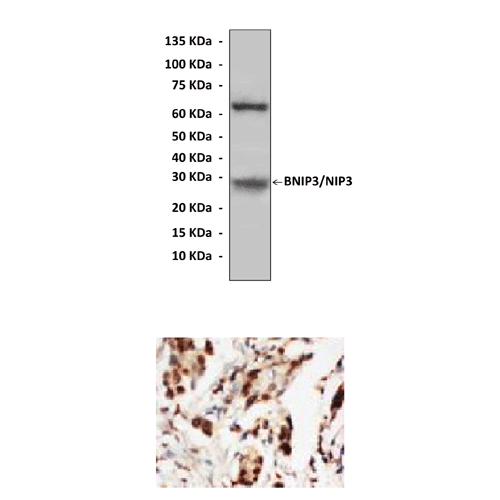Anti-BNIP3: Polyclonal BCL2-Interacting Protein Antibody |
 |
BACKGROUND BNIP3 (formerly known as NIP3) is a member of a unique subfamily of death-inducing mitochondrial proteins that includes NIX (also called BNIP3alpha and BNIP3L/B5) and a Caenorhabditis elegans ortholog, ceBNIP3. Bnip3 expression has been reported to be upregulated in neonatal myocytes subjected to hypoxia resulting in mitochondrial dysfunction and subsequent cell death. Bnip3 has been demonstrated to induce both necrotic and apoptotic cell death. BNIP3 family members contain a C-terminal transmembrane (TM) domain that is required for mitochondrial localization as well as for its proapoptotic activity. Many members of the BCL-2 family require a BCL-2 homology 3 (BH3) domain to induce apoptosis. BNIP3 contains a sequence that resembles a BH3 domain (amino acids 110 to 118). However, in the context of the BNIP3 protein, it has been shown that it is not required for heterodimerization with BCL-2 family members or cell death, both in vivo and in vitro, indicating that BNIP3 does not trigger apoptosis, like most BH3-containing proteins. It was shown that BNIP3 lacking its BH3-like domain is still able to heterodimerize with Bcl-2, Bcl-XL, or CED-9 and efficiently induce cell death and that this interaction occurs at the NH2 and COOH termini of the BNIP3 protein. Furthermore, although the BNIP3 TM domain targets it to the mitochondrion, the induction of apoptosis is nearly as efficient when BNIP3 is directed to nonmitochondrial sites following TM domain swapping.1 Thus, it is suggested that BNIP3 is part of a functionally unique subset of the Bcl-2 family, which also includes Mtd/Bok and Diva, that does not require a BH3-like domain to promote cell death at mitochondrial and nonmitochondrial sites. However, other studies suggested that BNIP3 activates a novel caspase-independent necrosis-like cell death pathway, which is mediated through the opening of the permeability transition pore.2 In addition, Activation of BNIP3 may lead to to autophagic cell death and Bnip3-induced mitochondrial dysfunction correlates with upregulation of autophagy as a protective response to remove damaged mitochondria.3
REFERENCES
1. Ray, R. et al: J. Biol. Chem. 275:1439-48, 2000
2. Velde, C.V. et al: Mol. Cell. Biol. 20:5454-68, 2000
3. Daido, S. et al: Cancer Res. 64:4286-93, 2004
2. Velde, C.V. et al: Mol. Cell. Biol. 20:5454-68, 2000
3. Daido, S. et al: Cancer Res. 64:4286-93, 2004
Products are for research use only. They are not intended for human, animal, or diagnostic applications.
Параметры
Cat.No.: | CA1302 |
Antigen: | N- terminal sequence of human Bcl-2/Adenovirus E1B 19KD-interacting protein 3 (NIP3 ). |
Isotype: | Affinity-Purified Rabbit Polyclonal IgG |
Species & predicted species cross- reactivity ( ): | Human, Rabbit, Rat, Mouse |
Applications & Suggested starting dilutions:* | WB 1:500 to 1:1000 IP n/d IHC (Paraffin) 1:50 to 1:200 ICC n/d FACS n/d |
Predicted Molecular Weight of protein: | 29 kDa |
Specificity/Sensitivity: | Detects endogenous BNIP3 proteins without cross-reactivity with other family members. |
Storage: | Store at 4° C for frequent use; at -20° C for at least one year. |
*Optimal working dilutions must be determined by end user.
Документы
Информация представлена исключительно в ознакомительных целях и ни при каких условиях не является публичной офертой








